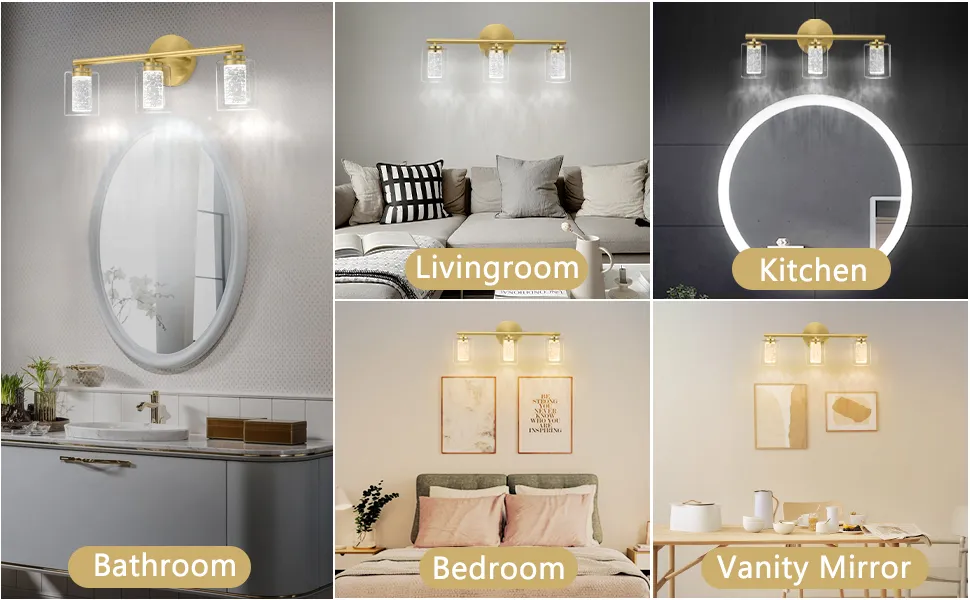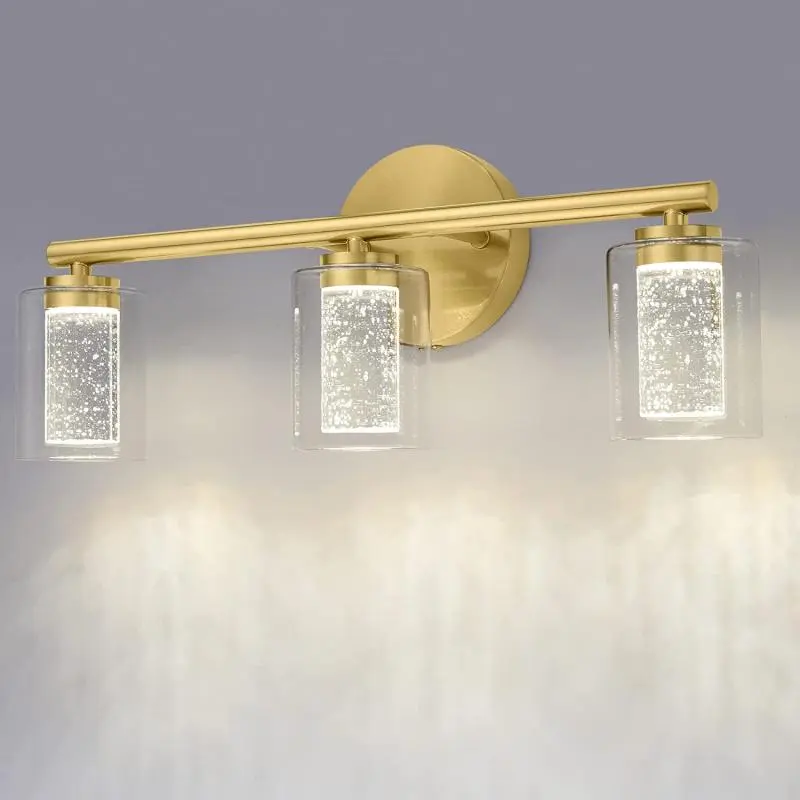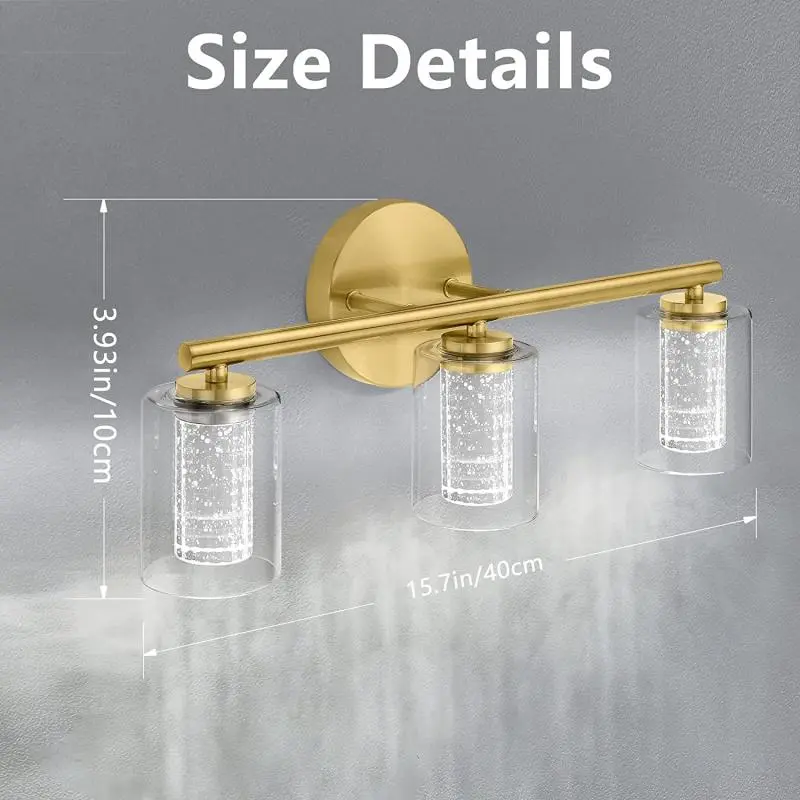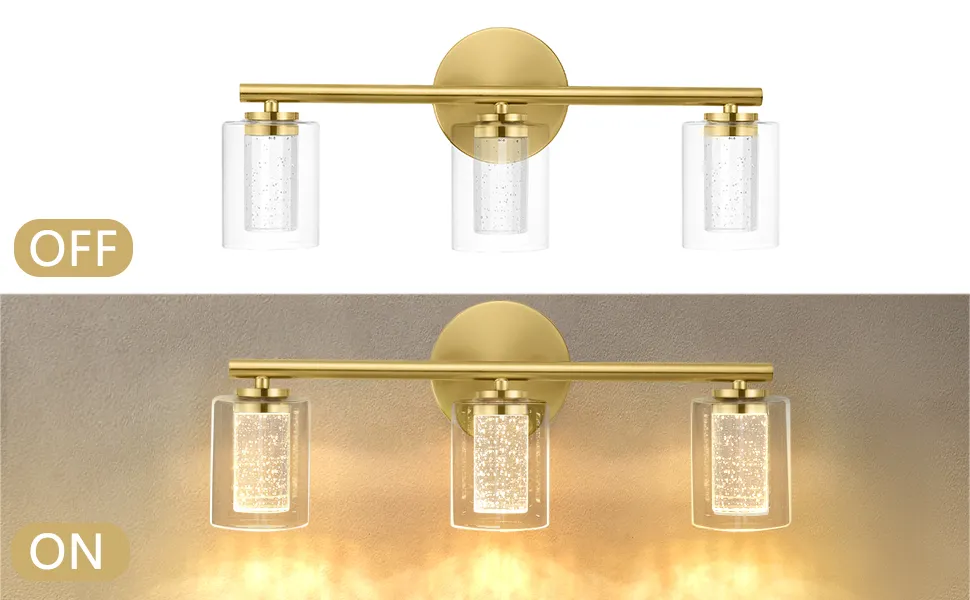Bathroom Vanity Lights: What's the Optimal Kelvin Rating?
The bathroom has long evolved beyond simply being a place for washing and brushing your teeth; it has become a crucial area for daily grooming, grooming, and applying makeup. As the core light source in this space, the quality of the light directly impacts visual comfort and practical experience. A common question among consumers is: What's the optimal Kelvin rating for bathroom vanity lights?
Based on lighting science and the principles of human visual adaptation, the answer is clear: the optimal color temperature range for bathroom vanity lights should be between 3000K and 5000K. This article will provide a professional analysis of bathroom vanity light color temperature selection from multiple perspectives, including optical principles, functional requirements, color temperature classification, lighting layout, and actual user experience.

What is the Kelvin rating?
Kelvin (K) Definition
• The Kelvin rating (K) is a unit of measurement for light source color temperature.
• It indicates the degree of warmth or coolness of light color. Lower values indicate a warmer, yellower light; higher values indicate a cooler, whiter, or even bluish light. In daily life, different color temperatures create different visual experiences.
Color Temperature Classification Standards
• Low Color Temperature (2700K–3000K): Warm yellow light creates a cozy and comfortable feeling, similar to candlelight or traditional incandescent light.
• Neutral Color Temperature (3500K–4500K): Close to natural white light with good color rendering, commonly used in offices and dressing rooms.
• High Color Temperature (5000K–6500K): Cool white light, even with a bluish tint, creates a clear and sharp image, but can cause glare with prolonged use.
Therefore, when choosing a Kelvin rating for bathroom vanity lighting, it's crucial to balance visual comfort and functionality, rather than prioritizing higher for brighter light or lower for softer light. Choosing the right color temperature directly impacts the uniformity of facial lighting, the faithful reproduction of makeup colors, and overall lighting comfort.

Why is 3000K–5000K the optimal range for bathroom vanity lighting?
1. Uniform light and faithful reproduction of skin tones
The primary function of bathroom vanity lighting is to provide precise facial illumination. A color temperature that is too low (e.g., 2000K–2700K) can cast skin tones in a yellowish hue, making makeup appear dull or distorted. A color temperature that is too high (e.g., above 5500K) can produce a cool white light, making skin appear pale or bluish, making it difficult to accurately judge the color of foundation and blush when applying makeup.
• 3000K–3500K: Warm white light, similar to the yellow tones of natural light, is suitable for daily skincare and a warm bathroom style.
• 4000K–5000K: Neutral white light, with true color reproduction, is suitable for delicate tasks like applying makeup and shaving.
Therefore, keeping the color temperature of bathroom vanity lighting within 3000K–5000K can achieve a balance between comfort and functionality.
2. Avoiding Visual Fatigue
Excessively high or low color temperatures can affect eye comfort. Low color temperatures can cause a dimming sensation, requiring higher brightness for clear vision; high color temperatures can be glaring and cause glare. A color temperature range of 3000K–5000K provides soft yet clear light, reducing visual fatigue and enhancing long-term user experience.
3. Compatible with Bathroom Style
Bathroom vanity lights not only provide illumination but also contribute to the interior ambiance. Warm tones (around 3000K) are suitable for creating a warm and relaxing atmosphere, while cool tones (4500K–5000K) suit modern minimalist styles, creating a bright and uncluttered appearance. Therefore, this color temperature range can flexibly adapt to different decorating styles.

Bathroom Vanity Lights: Color Temperature and Light Source Type
When choosing the appropriate color temperature for bathroom vanity lights, the light source type is also a key factor. Common light sources include incandescent, fluorescent, and LED. LEDs are preferred due to their long lifespan, controllable brightness, and diverse color temperatures.
1. Advantages of LED Bathroom Vanity Lights
• Adjustable Color Temperature: Some LED vanity lights can be adjusted within a range of 3000K–5000K to meet the needs of different scenarios.
• High Color Rendering Index (CRI ≥ 80): Ensures faithful reproduction of facial makeup colors.
• Low Energy Consumption: Consumes only 1/5 of the power of traditional incandescent lamps at the same brightness, saving energy and protecting the environment.
• Long Lifespan: High-quality LED lamps can last up to 25,000–50,000 hours, reducing maintenance costs.
For this reason, modern bathroom vanity lights often use LEDs, which can precisely control the color temperature between 3000K and 5000K, providing professional facial lighting.
Bathroom Vanity Lighting: The Impact of Different Color Temperatures on Makeup and Skincare
1. Low Color Temperature (Around 3000K)
The light is warmer and yellower, making it suitable for evening skincare or creating a warm atmosphere.
The color of makeup appears warmer, making it suitable for light and warm-toned makeup.
It is not suitable for carefully judging skin tones and lipstick colors, as color shifts can easily occur.
2. Neutral Color Temperature (Around 4000K)
The light is closer to natural sunlight, evenly illuminating the face with minimal shadows.
Makeup colors are faithfully reproduced, perfect for daily, detailed application.
Suitable for most bathroom decor styles and visually pleasing.
3. High Color Temperature (4500K–5000K)
Produces bright, clear light, perfect for a quick morning makeup application or shaving.
Although color reproduction is excellent, the light is cooler and requires a soft shade to avoid glare.
It is more suitable for modern, minimalist bathrooms, enhancing the sense of brightness.
Overall, keeping bathroom vanity lighting within the 3000K–5000K range can address both daily skincare and makeup needs, as well as overall visual comfort.
Bathroom Vanity Lighting: Comparing the Effects of Different Color Temperatures
Color Temperature Range | Light Characteristics | Visual Effects | Is it suitable for bathroom vanity lighting? |
| <3000K | Warm yellow with a reddish tint | Soft but dark, with a yellowish cast on skin tones | Not recommended |
| 3000K–3500K | Warm white light | Comfortable and natural, with a gentle atmosphere | Recommended for washing |
| 3500K–4000K | Neutral white light | Close to natural light, with excellent color rendering | Highly recommended for skincare and makeup |
| 4000K–5000K | Cool white light | Clear and sharp lighting, with excellent skin tone reproduction | Recommended for delicate makeup and shaving |
| >5000K | Cool bluish light | Too glare, with skin tones appearing pale | Not recommended |
Bathroom Vanity Lighting: Installation and Lighting Layout
Even if you choose the ideal color temperature, installation method will directly affect the lighting effect:
• Symmetrical Installation: Install wall lights on either side of the mirror to evenly cover the face and reduce shadows on the nose and chin.
• Centered Installation: Suitable for a single bathroom vanity light, but may create slight shadows and requires a diffuser.
• Lampshade Material: A frosted or creamy shade can soften the light, making the 3000K–5000K range more comfortable.
• Distance and Height: Ideally, place the lamp 30–50 cm from the mirror, at eye level, to ensure even light coverage across the face.
Through proper placement, even bathroom vanity lights with the same color temperature can achieve optimal lighting.
The Importance of Matching Color Rendering Index (CRI) and Color Temperature
The color temperature of light is only one part of the makeup application experience; the color rendering index (CRI) is equally crucial. High-CRI light sources faithfully reproduce colors and avoid color shifts in cosmetics. For bathroom vanity lights, a CRI of 80 or higher is recommended; high-quality LED vanity lights can even achieve a CRI of 90 or higher.
Within the 3000K–5000K color temperature range, high-CRI LED lights can naturally enhance skin tone, ensuring precise and reliable makeup and skincare applications.

What is the optimal Kelvin rating for bathroom vanity lights?
Taking into account optical principles, functional features, light source type, installation method, and color rendering, we offer the following professional recommendations:
• Optimal color temperature range: 3000K–5000K
• Low-end 3000K: Warm and soft, suitable for evening skincare or creating a cozy atmosphere
• Neutral 4000K: Close to natural light, suitable for daily makeup application
• High-end 5000K: Bright and clear, suitable for shaving or quick makeup application
To maximize the benefits of light, a bathroom vanity light with a high color rendering index (CRI ≥ 80) should be used. The installation should be tailored to the size of the mirror and the layout of the vanity.
Therefore, choosing a bathroom vanity light with a color temperature between 3000K and 5000K ensures comfortable and realistic lighting while meeting the needs of daily use, such as makeup and shaving. It is the most professional and reliable choice.
Is Huari a reliable supplier for LED night lights?
Absolutely. Our LED night light series includes motion sensor lamps, silicone decorative lights, and multifunctional night lights. All products are manufactured in our 92,000㎡ factory under strict ISO standards.
We supply international markets with CE and RoHS certified items that balance quality and affordability. Whether you want to buy in wholesale or order customized designs, we provide competitive prices and efficient service.
